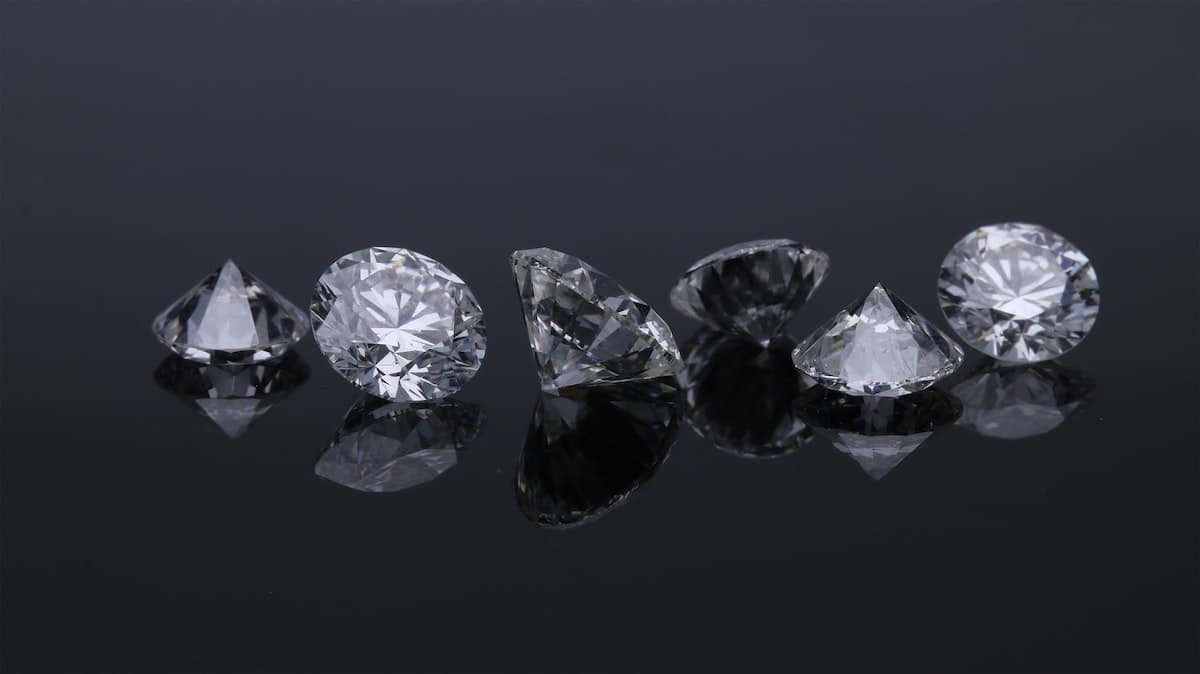Diamonds might be a girl’s best friend, but what is that friendship worth? Unlike many other commodities, diamonds aren’t as easy to value. There are a lot of factors that go into determining how much a diamond sells for, most of which aren’t precise at all. With such a vague way to price diamonds, it’s no wonder you might find it difficult to know what a diamond is worth.
The good news is that we’ve put together this short guide on how much a diamond is worth. Our information is based on facts and corroborated by several sources. In addition to teaching you about how diamonds are valued, we’ll also discuss where you can purchase diamonds without breaking the bank. After all, the more you know about how much a diamond is worth, the more savvy a jewelry shopper you’ll become.
Are you ready to see how much a diamond is worth and why? Let’s get started!
The Many Features of a Diamond
Knowing how much your diamond is worth begins with understanding how a diamond is valued. There’s a lot more to diamonds than just sparkle and shine. Instead, experts and even investors rely on the four Cs to distinguish one diamond from another.
These four Cs include carat weight, color, cut, and clarity. They’re often used when discussing diamonds in terms of engagement rings, earrings, and other fine jewelry. Let’s take a closer look at these individual characteristics to see how they add up to a diamond’s value.
Carat
Before we get too far into what a carat is, understand that it’s a completely different thing entirely than a karat (or a carrot, but you knew that). Karats are used to determine the purity of gold. They’re a critical part of jewelry knowledge, but not helpful to us in determining the value of a diamond.
The carat of a diamond refers to its weight, specifically in grams. A single carat is 0.2 grams. As you can imagine, the heavier a diamond, the larger the carat size. Between the four Cs, the carat has the biggest influence on pricing as it’s the best way to distinguish small diamonds from larger ones. As carat size increases, prices increase at a rapid rate.
At the same time, you’re always going to pay more for a new diamond than you would a second-hand one. It’s the same rule that plagues new cars, albeit without the continued depreciation.
Round carat numbers fetch the highest prices. For example, a single-carat diamond goes for more than one that is just slightly under or above that weight. If you are buying or selling a diamond, you can use this to your advantage. You can either sell a whole-carat diamond for more or purchase a less-than-whole-carat diamond for less.
Color
Cut and color won’t make a diamond shinier, no matter how much it weighs. If you’re looking for a diamond that will light up the room, you’ll want to place color at the top of your list.
Most engagement rings are typically K color and above. The color rating identifies where in the spectrum the diamond is between yellow and clear/colorless. As you can imagine, a diamond that is crystal clear sells for much more than one that’s a bit duller in color.
The color of a diamond can influence price. Diamonds with a Z rating are brown and have a yellowish tint. They’re typically worth less than diamonds that have a D rating, which defines a completely colorless jewel.
When considering color, it’s also important to understand how it will interact with the setting of the diamond. Diamonds of H color are good for platinum and white gold, while yellow gold and rose gold work best for J or K diamonds.
Cut
Of the three diamond facets we’ve discussed so far, cut is probably one of the more important behind the carat. It’s yet another way to define the size of the diamond and shouldn’t be confused with shape, though they are related. Cut refers to polish, symmetry, and proportion. Not all diamonds are cut the same way.
Expertly cut diamonds mask the inclusions and color that characterize lower-grade jewels. An ideal cut can make a diamond look bigger even if it carries the same carat weight as a similar diamond. Most jewelers denote their ideal cut diamonds with a specific brand name. For example, James Allen’s line is called TrueHearts. Astor by Blue Nile and Whiteflash’s A CUT ABOVE® are lineups of ideal cut diamonds as well.
Clarity
As much as jewelers want you to believe that flawed diamonds are inferior, it’s practically impossible to see most inclusions and blemishes with the naked eye. That’s why the term “eye-clean” came about, to refer to flaws you can’t see, even if they are there.
A diamond’s clarity can be expressed by inclusions (internal flaws) and blemishes (external flaws). Superior cuts will mask these imperfections, as we’ve mentioned, but nearly every diamond contains some sort of flaw. You just need to look at it in 10-times magnification.
Clarity levels include VVS2, VS2, SI2, I2, with I2 being the lowest grade. Most of your moderately priced diamonds are within the VS2 range of clarity.
Shape
Though not one of the four Cs, shape is yet another characteristic that sets diamonds apart. Round diamonds are the most expensive and traditional, with princess shapes coming in at a close second as a more contemporary shape. Oval-shaped diamonds can add a sophisticated twist to the mix, while pear and marquise diamonds can dwarf a round diamond visually.
Asscher and emerald cuts characterize vintage diamonds. If you’re looking for something less mainstream, you might choose a radiant or cushion cut that’s more square or rectangular.
Factors That Influence Diamond Pricing
Beyond the features of a diamond, there are other factors at play that influence the final pricing. For example, the degree of fluorescence can negatively affect the price of a diamond, though it has no bearing on the overall grade of the diamond itself. Rather, it’s more of a market preference than anything else.
Jeweler markups and policies can increase the price of a diamond as well. Offering a lifetime warranty and free resizing translates to a bit of a price hike in most cases. Prestigious names offer a higher standard of diamond and charge for it, too. Physical locations will charge more than online stores, as they have to address more overhead.
Let’s take a closer look at what other factors influence the price of a diamond.
Certification
Organizations such as the American Gem Society (AGS) and the Gemological Institute of America (GIA) certify diamonds based on lab tests. These diamonds come with a certificate that shows their characteristics in the form of the four Cs.
It’s important to note that while these certificates can add value to the quality of a diamond, GIA does not grade most fancy cuts. In addition, most jewelers will charge more for diamonds that are certified by GIA or AGS. Keep in mind that the FTC also allows jewelers to be one color and clarity grade off, so certification can help nail down those specific characteristics.
Natural vs. Lab Created
Another big debate in the diamond industry centers on natural versus lab-created diamonds. Lab-created diamonds are often cheaper and more popular, but they can be less than desirable for some people. You might have also heard lab-created diamonds referred to as “synthetic” diamonds.
You may also run into treated diamonds, which are natural diamonds that have been enhanced to increase their color and clarity. Treating can remove or fill in flaws as well as bring down the price of the diamond overall. However, this treatment process can weaken the diamond’s overall structure and cause it to break easier.
Where Can You Sell/Buy Diamonds
There are many places you can purchase and sell diamonds, both in-person and online. Here’s a quick breakdown of the pros and cons of these locations, whether you’re buying or selling:
- Local jeweler: Chain jewelers run ads during the holidays for diamonds, but they’re often the last place you want to go if you’re looking for a great deal. While they might sell select styles you just have to have, the markup on their diamonds could almost buy you another carat or two.
- Online stores: With little in the way of overhead, online stores offer some of the best diamond prices out there. You may not be able to see or touch the diamonds on these sites, they often offer some type of return/exchange policy in accommodation.
- Independent jeweler: These jewelers compete fiercely with chain jewelers for your business. They may not have a high overhead, but they do still charge a markup. Most people purchase diamonds here based on loyalty.
- Pawn shops: Even though diamond prices can be tempting at a pawn shop, there’s a lot to be said for making sure you’re getting the fair end of the deal. Selling your diamonds here will likely get you the least for your jewelry, especially when compared to online retailers.
The next time you visit a diamond website or local jeweler, you’ll have more knowledge to show off. This may or may not help you get a better price for the diamond you’ve been keeping an eye on.
Tips for Getting the Most Diamond for Your Money
Becoming a savvy diamond shopper can help you if you ever need to sell your diamond as well. Knowledge of the market goes a long way in ensuring you get more for what you pay for and sell. Here are some more tips for getting more diamond for what you spend:
- A single-carat diamond will cost you between $4,500 and $6,000. A half-a-carat diamond comes in at about a third of the price at $1,500. In contrast, a two-carat diamond can cost between $18,000 and $21,000.
- An eye-clean diamond shines just as bright as a VS2-rated diamond. Pair it with an H-colored diamond for the best result.
- Choose a cut other than round to save up to 40%.
- Online retailers such as James Allen, Blue Nile, and Whiteflash offer lower prices than most local jewelers in your area.
If you’re curious, you can also check out RapNet and IDEX Online Diamond Price Report to see what diamonds are worth in real time. It can be a great way to set the tone for both buying and selling diamonds.
FAQs
Diamonds may increase in value over time, but so has the cost of living. Inflation has mostly caught up to the value of diamonds, excluding those that are extremely rare and desirable.
Getting an appraisal done on your diamond ring is often the best way to determine how much it is worth. Just know that most diamonds are worth less as soon as they are purchased, as they’re a commodity that fluctuates in pricing, similar to gold.
Distinguishing the difference between diamonds that are lab-created and those that are naturally occurring is very difficult, even for diamond experts. However, if you want to know how to tell if your diamond ring is real, the best thing to do is to bring it to an appraiser or your local jewelry store. They can perform tests to determine if you own the real thing or not.
All That Sparkles May Not Be Diamonds
Knowing how much your diamond is worth can be tricky to figure out, especially if you’re not sure where to begin. We hope this article has helped you understand how you can evaluate your diamonds to sell them. On the flip side, the knowledge you gained from this article can help you weigh the prices of diamonds as well. With all this newfound expertise, you’re sure to get more for what you paid for it when purchasing diamonds. What you do with them afterward is up to you.








